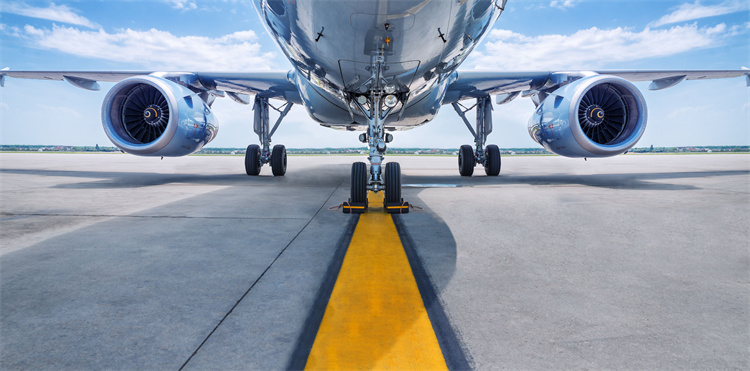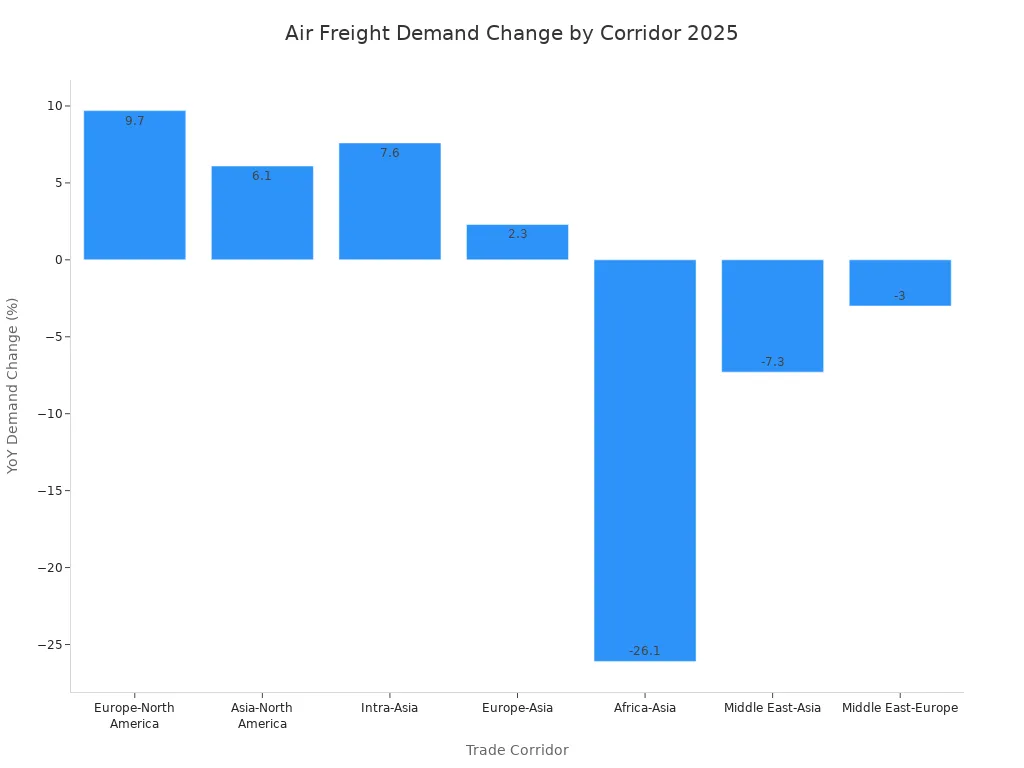Airfreight Logistics Trends to Watch for in the Coming Year

Airfreight logistics is changing fast in 2025. More people want air freight, but there is not enough space, especially on big routes. Companies must use agile air freight strategy, digital transformation, and automation to keep up. Logistics trends are moving toward sustainability and tougher rules. Businesses need good logistics partners and smart solutions like JUSDA’s warehouse services to handle these trends and improve air freight strategy.
Key Takeaways
Airfreight logistics is growing quickly because more people want it and there is less space. Companies need to use smart digital tools and flexible plans to keep up.
Technology like AI, automation, and real-time tracking helps make deliveries faster. It also lowers costs and helps handle risks in a changing market.
Sustainability and green practices are very important. Companies are using cleaner fuels and eco-friendly ways to work. They also follow new rules to help protect the environment.
Airfreight Logistics in 2025
Airfreight is changing a lot in 2025. Companies see new problems and chances. E-commerce, sustainability, and technology are making global freight different. JUSDA’s worldwide network and digital supply chain tools help companies keep up. They work in important places and focus on new ideas. This makes them leaders in logistics as things change.
Digital Transformation
Digital transformation helps airfreight work better and be clearer. Companies use IoT sensors to track cargo in real time. This helps stop delays and damage. Blockchain keeps documents and tracking safe. It also cuts down on paperwork and mistakes. AI and data analytics help companies guess demand and plan routes. Automation and robotics make cargo handling faster and with fewer errors. Cloud-based platforms let teams see shipment data anywhere. This helps people work together and see what is happening. These new tools help logistics companies react fast to changes and what customers want.
Note: Digital tools like JUSDA’s JusLink platform use real-time data, predictive analytics, and smart control. This lets companies manage everything from suppliers to customers.
AI and Automation
AI and automation are changing how airfreight works. JusLink’s AI Solution makes forecasting and restocking more accurate. This helps inventory move faster and costs go down. Companies use AI to plan routes, handle inventory, and automate warehouse jobs. Autonomous vehicles and drones make deliveries faster and can carry more. Predictive maintenance tools help cut down on repairs and waiting. These technologies show clear results:
Metric Category | Improvement/Outcome |
|---|---|
Delivery Efficiency | |
Cost Savings | 22% lower transportation costs |
Operational Efficiency | 35% less manual labor |
Productivity | 12% higher overall productivity |

AI-powered logistics tools help companies stay flexible, save money, and give better service in a fast-changing world.
Air Freight Market Trends
Demand and Capacity
In 2025, air freight demand is going up in many places. Europe-North America will see a 9.7% rise in demand. Asia-North America will go up by 6.1%. Intra-Asia will grow by 7.6%. But Africa-Asia will drop by 26.1%. Air cargo capacity is also getting bigger. In January 2025, total air cargo capacity went up by 6.8%. Passenger planes now carry over half of all international air cargo. This is 10% more than last year.
Aspect | Detail |
|---|---|
Demand Growth | Europe-North America +9.7% YoY; Asia-North America +6.1% YoY; Intra-Asia +7.6% YoY |
Capacity Growth | Total capacity +6.8% YoY; Passenger belly hold +10% YoY; Cargo aircraft +4.2% YoY |
Load Factor | Down 1.5 points YoY to 43.9% overall |
Drivers of Demand | E-commerce, strong manufacturing PMI, shipping disruptions |

E-commerce and steady factories are making air cargo busier. JUSDA’s worldwide network and digital tools help clients handle air cargo space. These tools also help them keep up with market changes. Companies use technology and smart plans to deal with tight space and stay reliable.
Pricing Pressures
Prices for air freight are still a big issue. In Q1 2025, freight rates went up by 2.6% from last year. Prices change a lot because of world events and seasons. New tariffs and trade rules, like U.S. tariffs on Chinese goods, make demand jump and cause slowdowns. Problems in the Red Sea and strikes at ports send more cargo to air freight. This makes prices go up on some routes.
Not enough space, equipment shortages, and new trade paths make prices harder to control. Shippers often book early or pick different routes to avoid waiting. JUSDA helps clients with network planning and supply chain tracking. This support helps them deal with air freight trends and keep costs down.
E-Commerce and Air Cargo Market

Growth Drivers
E-commerce is changing air cargo in 2025. Many things make this happen fast:
Cathay Cargo saw cargo tonnage go up by 11% in 2024. E-commerce shipments were the main reason for this growth.
The global cross-border e-commerce logistics market was $97.85 billion in 2023. It will grow by 25.4% each year until 2030.
Air cargo demand went up by 11.3% in 2024. This was mostly because of e-commerce shipments.
Asia-Pacific carriers now have 34.2% of the world’s air cargo market. They are growing fast on Europe-Asia and Middle East-Asia routes.
Shoppers still want fast delivery. About 80% want same-day shipping. 61% want their orders in 1 to 3 hours.
Big e-commerce companies like Amazon want to grow their air fleets. They do this to meet these fast delivery needs.
JUSDA’s work with Sharp shows how digital supply chain tools help. These tools lower logistics costs, make orders arrive faster, and improve accuracy. Technology like AI forecasting and automated warehouses helps companies keep up. This is important for the fast world of e-commerce and air cargo.
Urban Logistics
Urban logistics has many problems as e-commerce grows. Cities have more traffic, high land costs, and noise. Big trucks make traffic and pollution worse. Failed deliveries and returns waste time and money. Companies use different ways to fix these issues:
Micro-fulfillment centers in cities make deliveries shorter.
Electric vans and bikes help cut down on pollution.
Route optimization tools help drivers skip traffic and deliver faster.
Delivery lockers and smart lockboxes keep packages safe and easy to get.
Shared transshipment hubs move cargo to smaller vehicles for last-mile delivery.
JUSDA’s global warehouse network helps e-commerce by putting goods closer to buyers. Their advanced systems, like JusLink and eVMI, give real-time updates and control. These tools help companies meet the needs of today’s air cargo market. They also help keep e-commerce shipping fast and reliable.
Sustainability in Air Freight

Green Initiatives
Air freight companies want to help the environment. Many airlines use sustainable aviation fuel. This fuel can lower carbon emissions by up to 80%. It is made from renewable sources and works in today’s planes. This makes it a good way to cut carbon. Companies also upgrade their fleets. They use lighter parts and engines that save energy.
Electric and hybrid aircraft are being made to cut emissions more.
Airports use green energy and electric machines for cargo.
Digital tools like carbon trackers and IoT sensors watch emissions.
Carbon offset programs help plant trees and support green energy.
AI tools help plan routes and load cargo to save energy.
Sustainable aviation fuel and better operations lower air freight’s carbon footprint. These actions, with teamwork across the industry, help companies reach big sustainability goals.
Regulatory Compliance
Following rules is important for greener logistics. New laws make companies track and report carbon emissions. They must use green practices and follow local and global standards. Doing this cuts carbon and builds trust with customers and partners.
JUSDA shows it cares about the environment. Its warehouses meet strict green rules. The company uses clean energy, smart inventory systems, and green packaging. This helps lower harm to the environment. JUSDA keeps up with new rules and uses new ideas. This makes JUSDA a leader in green air freight logistics.
Supply Chain Resilience
Risk Management
Supply chain resilience is very important in airfreight logistics for 2025. Companies often deal with problems like bad weather and world events. Demand can change quickly too. Air freight is fast and flexible. It helps businesses react to these problems. Some things help make supply chains stronger:
Fast transit times help when shipments are urgent.
Flexible routing lets companies change plans if needed.
Reliable schedules mean deliveries happen on time.
Global reach connects markets all over the world.
Secure handling and tracking help lower risks.
Using different transport modes makes logistics smoother.
Working with good logistics partners gives more control.
Good risk management means working with trusted suppliers. Companies check shipments before they leave. They keep the right amount of inventory. Cargo insurance protects goods if something goes wrong. Advanced tracking tools help watch shipments closely. Companies follow rules and keep paperwork correct. This helps avoid delays. JUSDA’s network and local knowledge help companies stay flexible. They also help reduce problems in the supply chain.
Real-time data and smart analytics help teams see risks early. They can act fast to stop supply chain problems from getting worse.
Technology Integration
Technology helps supply chains move faster and be clearer. Digital platforms like JusLink and warehouse VMI track shipments in real time. They also automate many jobs and help people make better choices. IoT sensors check cargo conditions. AI analytics help plan routes and guess delays. These tools make it easier to see what is happening. They also help companies manage risks before they become big problems.
New trends include using digital twins, blockchain, and AI. These tools help companies see more and guess when problems might happen. Dashboards and real-time alerts help teams make quick decisions. They also keep things running well. JUSDA’s digital tools and cloud systems help teams work together. They can respond fast and keep doing a good job, even if there are supply chain problems.

SMART JusLink
Supply Chain Management Solution
Some big airfreight logistics trends are fast e-commerce growth, new digital tools, and more focus on being green. Companies need to be flexible and use digital solutions. JUSDA’s global warehouse services and skills help businesses stay ahead. Leaders should use technology, care about the environment, and plan smart to get ready for the future.
See Also
Exploring The Latest Developments In Sea Freight 2024
Understanding Emerging Trends In Logistics Risk Management
Innovations Driving The Future Of Logistics Technology
